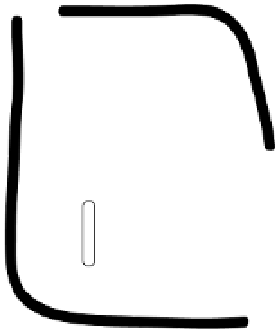Graphics Reference
In-Depth Information
(a)
(b)
Figure 2.20.
(a) An original image with foreground/background scribbles. (b) A hard segmen-
tation produced with graph cuts.
proposed to compute the histograms of the labeled pixels to approximate probability
density functions
f
F
(
I
)
and
f
B
(
I
)
, and to let
w
i
,
F
=−
λ
log
f
B
(
I
i
)
(2.84)
w
i
,
B
=−
λ
log
f
F
(
I
i
)
For example, if
f
B
(
is very low, then
w
i
,
F
will be very high, making it much more
likely that the edge between
i
and
I
i
)
B
is cut. The inter-node weights are computed
using a simple similarity measure
exp
2
1
dist
−
I
i
−
I
j
w
ij
=
(2.85)
(
)
2
i
,
j
2
σ
could be estimated based on the local
contrast of an image sample. Figure
2.20
illustrates a segmentation of an image from
scribbles with this original graph-cut formulation. If the segmentation is incorrect in
a subregion, new foreground/background scribbles can be added and the solution
quickly updated without recomputing the minimum cut from scratch.
Finding theminimum cut is actually the same as minimizing a Gibbs energy of the
form of Equation (
2.54
) when
Blake et al. [
49
] showed how the parameter
σ
is restricted to be binary (i.e., 0 for background and
1 for foreground). The edge weights between pixels and the foreground/background
terminals make up the data energy term
E
data
and the inter-node weights make up
the smoothness energy
E
smoothness
. That is,
α
E
data
(α
i
=
0
)
=
0
E
data
(α
i
=
1
)
=∞
i
∈
B
E
data
(α
i
=
0
)
=∞
E
data
(α
i
=
1
)
=
0
i
∈
F
(2.86)
E
data
(α
i
=
0
)
=−
λ
log
f
B
(
I
i
)
E
data
(α
i
=
1
)
=−
λ
log
f
F
(
I
i
)
otherwise
exp
(2.87)
2
−
I
i
−
I
j
1
dist
E
smoothness
(α
i
,
α
)
=|
α
−
α
|·
j
i
j
(
i
,
j
)
2
σ
2







